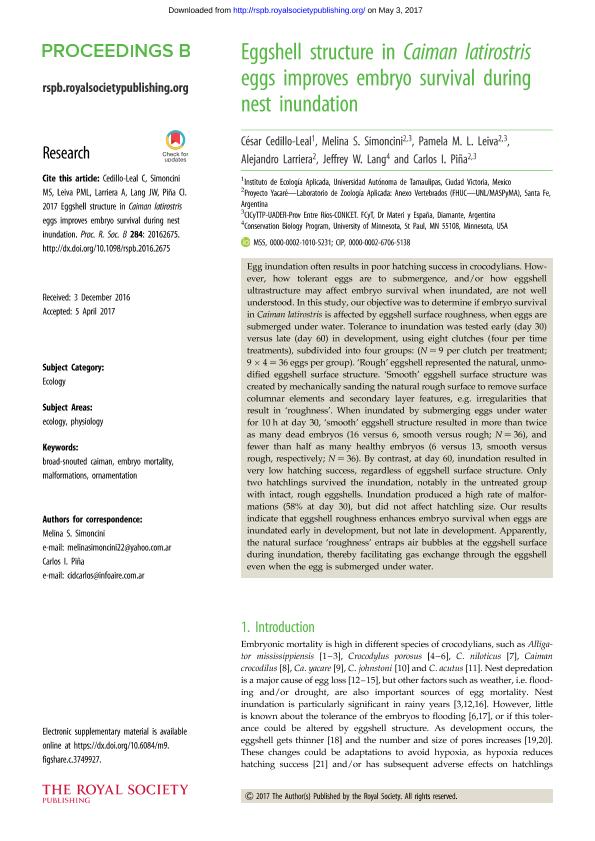Mostrar el registro sencillo del ítem
dc.contributor.author
Cedillo Leal, César
dc.contributor.author
Simoncini, Melina Soledad

dc.contributor.author
Leiva, Pamela Maria de Lujan

dc.contributor.author
Larriera, Alejandro

dc.contributor.author
Lang, Jeffrey W.
dc.contributor.author
Piña, Carlos Ignacio

dc.date.available
2018-11-23T21:22:08Z
dc.date.issued
2017-05
dc.identifier.citation
Cedillo Leal, César; Simoncini, Melina Soledad; Leiva, Pamela Maria de Lujan; Larriera, Alejandro; Lang, Jeffrey W.; et al.; Eggshell structure in Caiman Latirostris eggs improves embryo survival during nest inundation; The Royal Society; Proceedings of the Royal Society of London. Series B: Biological Sciences; 284; 1854; 5-2017; 1-6
dc.identifier.issn
0962-8452
dc.identifier.uri
http://hdl.handle.net/11336/65086
dc.description.abstract
Egg inundation often results in poor hatching success in crocodylians. However, how tolerant eggs are to submergence, and/or how eggshell ultrastructure may affect embryo survival when inundated, are not well understood. In this study, our objective was to determine if embryo survival in Caiman latirostris is affected by eggshell surface roughness, when eggs are submerged under water. Tolerance to inundation was tested early (day 30) versus late (day 60) in development, using eight clutches (four per time treatments), subdivided into four groups: (N = 9 per clutch per treatment; 9 × 4 = 36 eggs per group). ‘Rough’ eggshell represented the natural, unmodified eggshell surface structure. ‘Smooth’ eggshell surface structure was created by mechanically sanding the natural rough surface to remove surface columnar elements and secondary layer features, e.g. irregularities that result in ‘roughness’. When inundated by submerging eggs under water for 10 h at day 30, ‘smooth’ eggshell structure resulted in more than twice as many dead embryos (16 versus 6, smooth versus rough; N = 36), and fewer than half as many healthy embryos (6 versus 13, smooth versus rough, respectively; N = 36). By contrast, at day 60, inundation resulted in very low hatching success, regardless of eggshell surface structure. Only two hatchlings survived the inundation, notably in the untreated group with intact, rough eggshells. Inundation produced a high rate of malformations (58% at day 30), but did not affect hatchling size. Our results indicate that eggshell roughness enhances embryo survival when eggs are inundated early in development, but not late in development. Apparently, the natural surface ‘roughness’ entraps air bubbles at the eggshell surface during inundation, thereby facilitating gas exchange through the eggshell even when the egg is submerged under water.
dc.format
application/pdf
dc.language.iso
eng
dc.publisher
The Royal Society

dc.rights
info:eu-repo/semantics/openAccess
dc.rights.uri
https://creativecommons.org/licenses/by-nc-sa/2.5/ar/
dc.subject
Broad-Snouted Caiman
dc.subject
Embryo Mortality
dc.subject
Malformations
dc.subject
Ornamentation
dc.subject.classification
Otras Ciencias Biológicas

dc.subject.classification
Ciencias Biológicas

dc.subject.classification
CIENCIAS NATURALES Y EXACTAS

dc.title
Eggshell structure in Caiman Latirostris eggs improves embryo survival during nest inundation
dc.type
info:eu-repo/semantics/article
dc.type
info:ar-repo/semantics/artículo
dc.type
info:eu-repo/semantics/publishedVersion
dc.date.updated
2018-10-23T20:16:22Z
dc.journal.volume
284
dc.journal.number
1854
dc.journal.pagination
1-6
dc.journal.pais
Reino Unido

dc.journal.ciudad
Londres
dc.description.fil
Fil: Cedillo Leal, César. Universidad Autónoma de Tamaulipas; México
dc.description.fil
Fil: Simoncini, Melina Soledad. Provincia de Entre Ríos. Centro de Investigaciones Científicas y Transferencia de Tecnología a la Producción. Universidad Autónoma de Entre Ríos. Centro de Investigaciones Científicas y Transferencia de Tecnología a la Producción. Consejo Nacional de Investigaciones Científicas y Técnicas. Centro Científico Tecnológico Conicet - Santa Fe. Centro de Investigaciones Científicas y Transferencia de Tecnología a la Producción; Argentina. Universidad Nacional del Litoral. Facultad de Humanidades y Ciencias; Argentina
dc.description.fil
Fil: Leiva, Pamela Maria de Lujan. Provincia de Entre Ríos. Centro de Investigaciones Científicas y Transferencia de Tecnología a la Producción. Universidad Autónoma de Entre Ríos. Centro de Investigaciones Científicas y Transferencia de Tecnología a la Producción. Consejo Nacional de Investigaciones Científicas y Técnicas. Centro Científico Tecnológico Conicet - Santa Fe. Centro de Investigaciones Científicas y Transferencia de Tecnología a la Producción; Argentina. Universidad Nacional del Litoral. Facultad de Humanidades y Ciencias; Argentina
dc.description.fil
Fil: Larriera, Alejandro. Universidad Nacional del Litoral. Facultad de Humanidades y Ciencias; Argentina
dc.description.fil
Fil: Lang, Jeffrey W.. University of Minnesota; Estados Unidos
dc.description.fil
Fil: Piña, Carlos Ignacio. Provincia de Entre Ríos. Centro de Investigaciones Científicas y Transferencia de Tecnología a la Producción. Universidad Autónoma de Entre Ríos. Centro de Investigaciones Científicas y Transferencia de Tecnología a la Producción. Consejo Nacional de Investigaciones Científicas y Técnicas. Centro Científico Tecnológico Conicet - Santa Fe. Centro de Investigaciones Científicas y Transferencia de Tecnología a la Producción; Argentina. Universidad Nacional del Litoral. Facultad de Humanidades y Ciencias; Argentina
dc.journal.title
Proceedings of the Royal Society of London. Series B: Biological Sciences

dc.relation.alternativeid
info:eu-repo/semantics/altIdentifier/doi/http://dx.doi.org/10.1098/rspb.2016.2675
dc.relation.alternativeid
info:eu-repo/semantics/altIdentifier/url/http://rspb.royalsocietypublishing.org/content/284/1854/20162675
Archivos asociados
